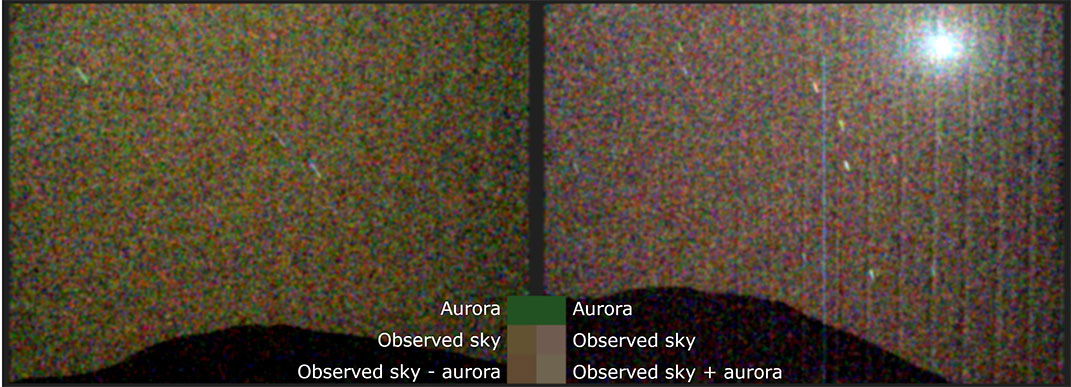Scientists have revealed that NASA’s Perseverance rover successfully captured a luminous phenomenon in the Martian skies that had never been previously recorded.
In March 2024, Mars experienced a brilliant aurora that turned the skies above its poles green during a powerful solar storm, producing the first visible-light Martian aurora ever recorded.
The red planet‘s magnetic fields interacted with particles ejected from the Sun to create the unusually hued sky. Over the years, scientists with an eye toward Mars have detected many auroras, yet all were in the ultraviolet spectrum. Last year’s event represents the first case of a visible aurora.
Perseverance Catches an Aurora in the Act
NASA’s Perseverance rover captured the event with its MastCam-Z and SuperCam instruments on March 18, 2024. The robotic explorer required a precise array of capabilities to record a visible-light aurora, including sensitivity to low-light conditions, high spectral resolution, and a flexible enough schedule to take advantage of unexpected opportunities.
The team made earlier attempts to position Perseverance to observe auroras as far back as 2023, but this was their first success after continually revising their prediction parameters.
 Credit: KNUTSEN ET AL., SCI. ADV. 11, EADS1563 (2025)
Credit: KNUTSEN ET AL., SCI. ADV. 11, EADS1563 (2025)
Researchers predicted the aurora after an intense solar storm in Active Region 13599 produced a coronal mass ejection on March 15, which they discovered through NASA’s CCMC Space Weather Database of Notifications, Knowledge, and Information.
After three days traveling through space, the ejection’s shock front impacted the Martian magnetosphere. The event was a gradual aurora, which the team had been focusing on since the lifespans of impulsive auroras are too short to organize observations. The Martian moon Phobos further contributed to illuminating the sky that night.
The Auroras of Mars
In our solar system, every atmosphere-bearing planet hosts auroras when its magnetic fields encounter solar particles. On Earth, these events typically occur at high latitudes in regions like the Arctic and Antarctic. Humans can normally observe them as brilliant spirals, sheets, and rays in radiant colors, including blue, red, and green. Solar wind, driven by coronal mass ejections, pushes particles through space to impact planets’ atmospheres and magnetic fields, generating these events.
Across the solar system, not just planets but even natural satellites and comets can experience auroras. With even stronger magnetic fields than Earth’s, researchers have recorded auroras on Jupiter and Saturn using the Hubble Space Telescope and other platforms. Particularly interesting is Jupiter, whose moon, Io, produces plasma that interacts with its host planet to create brilliant auroras.
Magnetic Mars
Prehistoric crustal magnetization and a conductive ionosphere left Mars with a hybrid magnetosphere, combining elements of induced and intrinsic fields. As far as astronomers presently know, this hybrid magnetosphere is unique in our solar system. This complex magnetic morphology results in Mars experiencing highly diverse auroral phenomena. These events have taken many shapes in earlier observations, including global, localized, and full dayside coverage. Their power can range from tens to hundreds of electron volts.
Due to their correlation with solar energetic particle events, astronomers can accurately forecast when auroras will occur on Mars. Solar particles generally reach the red planet in about three days. Once they hit the magnetosphere, auroras can range from impulsive hourly events to gradual occurrences over multiple days.
Next Steps in Auroral Research
Before the detections by Perseverance, only orbital platforms had observed Martian auroras. The 2024 event marks the surface recording of the phenomenon, and also the first time an aurora has been detected on the Martian nightside. However, in the past, nightside auroras have been detected elsewhere in the solar system, namely Venus.
The researchers suggest their project lays the groundwork for observing phenomena like temporal auroral variability and spatial structures, which are challenging to detect from orbit. Such information would provide scientists with new insight into the dynamics of Mars’ magnetotail.
To follow up on their work, the team recommends that future researchers adapt their observation methods to record any variability between orbital and surface platforms for comparison to other space weather events.
The paper “Detection of Visible-wavelength Aurora on Mars” appeared on May 14, 2025, in Science Advances.
Ryan Whalen covers science and technology for The Debrief. He holds an MA in History and a Master of Library and Information Science with a certificate in Data Science. He can be contacted at ryan@thedebrief.org, and follow him on Twitter @mdntwvlf.

